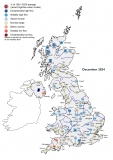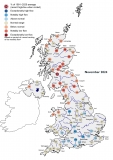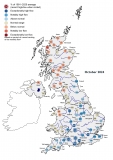Submitted by Steve Turner on
May was unsettled, but despite frequent showers and widespread thunderstorms, was largely quiescent in hydrological terms. It was moderately warmer than average with some hotter periods, especially in the south. While western Scotland was wet, it was mostly drier-than-average elsewhere, and especially dry in parts of Wales and central and eastern England. For much of the UK, spring (March-May) has been dry, continuing a general trend towards dry spring months in recent years, and longer-term rainfall deficiencies can be traced back to the autumn. Correspondingly, May mean river flows were below normal (notably so in some catchments) away from western Scotland, and groundwater levels were below normal at a majority of boreholes (again, notably so in some localities). Similarly, while reservoir stocks were moderately below average nationally, there were more pronounced deficiencies in Wales (16% below average for Wales as whole, with new May minima in Brianne and the Elan Valley), the Pennines, southwest England and at some reservoirs in southeast England (Ardingly registered the lowest May stocks on record). With below average flows, groundwater levels and reservoir stocks entering summer (and the dry and warm conditions in early June), increased vigilance will be required as evaporation rates climb. Current Outlooks suggest below normal flows and groundwater levels are likely to persist through summer, implying the possibility of localised impacts (e.g. on agriculture and the environment) if these forecasts are realised.



